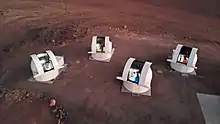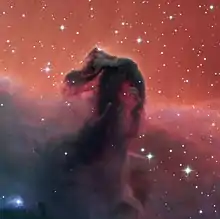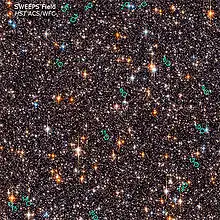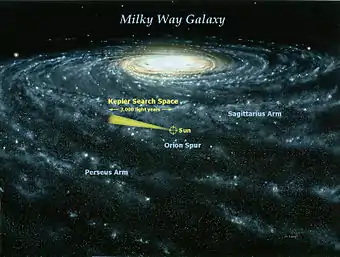SPECULOOS
SPECULOOS (Search for habitable Planets EClipsing ULtra-cOOl Stars) is a project consisting of SPECULOOS Southern Observatory (SSO) at the Paranal Observatory in Chile and SPECULOOS Northern Observatory (SNO) at the Teide Observatory in Tenerife.[1][2]
 | |
| Alternative names | SPECULOOS |
|---|---|
| Location(s) | Paranal Observatory, Teide Observatory, Chile, Spain |
| Coordinates | 24°36′56″S 70°23′25″W |
| Organization | European Southern Observatory University of Liège |
| Telescope style | astronomical survey infrared telescope Ritchey–Chrétien telescope |
| Number of telescopes | 5 |
| Diameter | 1 m (3 ft 3 in) |
| Website | www |
The SSO consists of four Ritchey–Chrétien telescopes of 1-metre primary aperture, made by ASTELCO. Each telescope is equipped with a NTM-1000 robotic mount and will search for Earth-sized exoplanets around 1000 ultra-cool stars and brown dwarfs.[3][4][5][6][7] As of June 2019, the SNO consists of one telescope, but more might be added in the future with up to three telescopes for SNO.[8] SPECULOOS is complemented by SAINT-EX and TRAPPIST.[9]
Science overview
Ultra-cool dwarf stars and brown dwarfs have a small radius, causing the transits caused by planets to be deeper. This allows the detection of terrestrial planets around these dwarfs, which are predicted to be common around brown dwarfs.[10] The TRAPPIST-1 system showed that ultra-cool dwarfs form terrestrial planets in the habitable zone. For brown dwarfs it was predicted that 175 of these objects need to be monitored to find one system with transiting planets.[11]
During the survey operation each telescope will observe one target for about 10 nights. This kind of observation is optimized for each target to find exoplanets in the habitable zone. To observe 500 targets in the southern hemisphere 1200 nights or 5 years are needed. The continuous observation of one target is needed to find these exoplanets in the habitable zone around ultra-cool dwarf stars. Such planets are expected to have a short transit duration, which can be small as 15 minutes.[12]
Individual telescopes and first light

The system of SPECULOOS - South (SSO) comprises four telescopes called Europa, Io, Callisto, and Ganymede. The telescopes are named after the Galilean moons that orbit the planet Jupiter, the most massive planet in the solar system. The first telescope (Europa) saw its first light in April 2017.[13] The second telescope (Io) began operations in October 2017.[14] As of December 2019, all SPECULOOS - South telescopes are operational.[1] ESO released first light images of SPECULOOS - South on the 2018-12-05. The telescopes did take images of the Carina Nebula, the Horsehead Nebula and the spiral galaxy Messier 83.[2] Artemis is the first telescope for SPECULOOS - North (SNO) it began operations on June 20, 2019.[1]
The robotic observations of each of the four telescopes is controlled by the program ACP Expert.[15] Each telescope is equipped with an Andor Peltier-cooled deeply depleted 2k × 2k CCD camera and the telescopes have a 12 × 12 arcminutes field of view.[12]
Wavelength
The four 1 m-diameter telescopes will be equipped with cameras sensitive in the near-infrared, the wavelength range in which ultra-cool stars and brown dwarfs emit most of their light. The detectors are optimized for 700 to 1000 nm wavelength, to observe ultracool dwarfs with a J-band magnitude of 14 or brighter at good seeing conditions.[12]
Collaboration
SPECULOOS involves scientists from the University of Liège (Belgium), the University of Birmingham (UK), the Cavendish Laboratory, Cambridge (UK), the University of Bern (Swiss), the Massachusetts Institute of Technology, Instituto de Astrofísica de Canarias and the King Abdulaziz University (Saudi Arabia), under the leadership of Michaël Gillon of the University of Liège. The European Southern Observatory (ESO) supports and hosts the SPECULOOS Southern Observatory (SSO) at the Paranal Observatory.[2][9]
Name
As with the other space observation projects of the University of Liège like TRAPPIST, the name Search for habitable Planets EClipsing ULtra-cOOl Stars makes up a backronym referring to the traditional Belgian spiced biscuit known as Speculoos.
Results
SPECULOOS was involved in the discovery of the exoplanet K2-135b, the exoplanets around L98-59 and the planetary system TOI-178.[16][17] SAINT-EX, which is part of the SPECULOOS project helped in the discovery of the planets around TOI-1266.[16]
The first light data of the SPECULOOS telescopes revealed the eclipsing binary brown dwarf 2M1510A, which is only the second eclipsing binary brown dwarf found so far.[18] The data by SPECULOOS did help to characterise low-mass eclipsing binaries and plays an important part in the follow-up of a new class of rapid rotating low-mass stars.[16]
See also
- TRAPPIST another project of the University of Liège to search for exoplanets
References
- "SPECULNEW - SPECULOOS-Nord (SNO)". www.speculoos.uliege.be. Retrieved 2020-03-10.
- information@eso.org. "First Light for SPECULOOS - Four telescopes devoted to the search for habitable planets around nearby ultra-cool stars get off to a successful start at ESO's Paranal Observatory". www.eso.org. Retrieved 2020-03-10.
- "Université de Liège - Life elsewhere in the Universe? A new nearby planetary system could bring soon the answer". Ulg.ac.be. 2016-07-20. Retrieved 2016-08-01.
- "Speculoos". Orca.ulg.ac.be. Retrieved 2016-08-01.
- Samuel Reich, Eugenie (2013-10-29). "Astronomers revisit dwarf stars' promise". Nature News. 502 (7473): 606. doi:10.1038/502606a. PMID 24172958.
- "SPECULOOS, a search for terrestrial planets transiting the nearest ultra-cool stars (Speaker: Michael Gillon)". Space.mit.edu. Retrieved 2016-08-01.
- "Research". SPECULOOS. Retrieved 23 February 2017.
- "3Q: Julien de Wit on Searching for Red Worlds in the Northern Skies | MIT Department of Earth, Atmospheric and Planetary Sciences". eapsweb.mit.edu. Retrieved 2020-03-10.
- "SPECULNEW - The Project". www.speculoos.uliege.be. Retrieved 2020-03-10.
- Payne, Matthew J.; Lodato, Giuseppe (November 2007). "The potential for Earth-mass planet formation around brown dwarfs". MNRAS. 381 (4): 1597–1606. arXiv:0709.0676. Bibcode:2007MNRAS.381.1597P. doi:10.1111/j.1365-2966.2007.12362.x. ISSN 0035-8711. S2CID 18055969.
- He, Matthias Y.; Triaud, Amaury H. M. J.; Gillon, Michaël (January 2017). "First limits on the occurrence rate of short-period planets orbiting brown dwarfs". MNRAS. 464 (3): 2687–2697. arXiv:1609.05053. Bibcode:2017MNRAS.464.2687H. doi:10.1093/mnras/stw2391. ISSN 0035-8711. S2CID 53692008.
- Burdanov, Artem; Delrez, Laetitia; Gillon, Michaël; Jehin, Emmanuël (2018). SPECULOOS Exoplanet Search and Its Prototype on TRAPPIST. Haex. pp. 1007–1023. arXiv:1710.03775. Bibcode:2018haex.bookE.130B. doi:10.1007/978-3-319-55333-7_130. ISBN 978-3-319-55332-0. S2CID 54016210.
- Europa First light!. SPECULOOS. 20/04/2017
- Io, Europa’s young brother is installed. SPECULOOS. 04/10/2017
- "SPECULOOS Southern Observatory".
- Sebastian, D.; Pedersen, P. P.; Murray, C. A.; Ducrot, E.; Garcia, L. J.; Burdanov, A.; Pozuelos, F. J.; Delrez, L.; Wells, R.; Dransfield, G.; Gillon, M. (2021-01-01). "Development of the SPECULOOS exoplanet search project". arXiv e-prints. 2101: arXiv:2101.10970.
- Leleu, A.; Alibert, Y.; Hara, N. C.; Hooton, M. J.; Wilson, T. G.; Robutel, P.; Delisle, J.-B.; Laskar, J.; Hoyer, S.; Lovis, C.; Bryant, E. M. (2021-01-01). "Six transiting planets and a chain of Laplace resonances in TOI-178". arXiv e-prints. 2101: arXiv:2101.09260.
- Triaud, Amaury H. M. J.; Burgasser, Adam J.; Burdanov, Artem; Kunovac Hodžić, Vedad; Alonso, Roi; Bardalez Gagliuffi, Daniella; Delrez, Laetitia; Demory, Brice-Olivier; de Wit, Julien; Ducrot, Elsa; Hessman, Frederic V. (January 2020). "An Eclipsing Substellar Binary in a Young Triple System discovered by SPECULOOS". Nature Astronomy. 4 (7): 650–657. arXiv:2001.07175. Bibcode:2020NatAs.tmp...43T. doi:10.1038/s41550-020-1018-2. S2CID 210839528.


